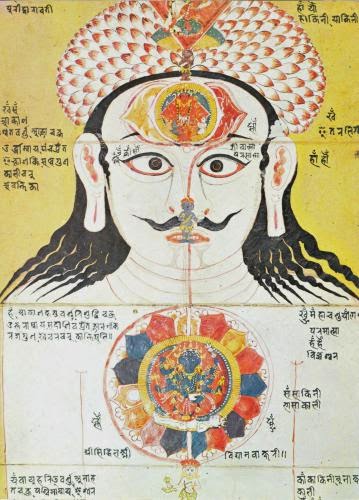
"
The crown, brow (AGNI"), and throat "chakras", Rajasthan, India, 18th century (wiki)
"
Om or aum" (Themeplus/flickr.com)
"Chakras" (subtle energy centers of the body) play an important role in the main surviving branch of Indian Vajrayana, TIBETAN BUDDHISM.
They play a pivotal role in COMPLETION STAGE practices, where an attempt is made to bring the subtle airs or winds of the body into the central channel, to realize the clear light of bliss and emptiness, and to attain BUDDHAHOOD (Geshe Kelsang Gyatso, "CLEAR LIGHT OF BLISS: A TANTRIC MEDITATION MANUAL").
The VAJRAYANA system states that the central channel ("avadhuti") begins at the point of THE THIRD EYE like the of Lord Shiva, curves up to the crown of the head, and then goes straight down to the lower body.
There are two side channels, the "rasana" and "lalana", which start at their respective nostrils and then travel down to the lower body. The "apana VaYU" (down-moving wind, where "wind" means the invisible power to move) governs the lower terminations of the three channels. The lower end of the central channel ends at the rectum. The lower end of the "lalana" ends in the urinary tract. The lower end of the "rasana" channel emits semen.
"
Chakra "picture produced by AuraStar2000TM bio-energy sensor (William Vroman/WIKI)
"
Buddha aum" (BrookeMontes/flickr)
The side channels run parallel to the center channel, except at locations such as the navel, heart, throat, and crown (i.e., the "chakras") where the two side channels twist around the central channel. At the navel, throat, and crown, there is a twofold knot caused by each side channel twisting once around the central channel.
At the heart wheel there is a sixfold knot, where each side channel twists around three times. An important part of completion stage practice involves loosening and undoing these knots. Within the "chakras" exist the "subtle drops." The white drop exists in the crown, the red drop exists in the navel, and at the heart exists the indestructible red and white drop, which leaves the body at the time of death.
"
Sanskrit characters (sriaurobindoashram.com)
In addition, each chakra" has a number of "spokes" or "petals," which branch off into thousands of subtle channels running to every part of the body, and each contains a SANSKRIT SYLLABLE.
By focusing on a specific "chakra" (while often holding the breath) the subtle winds enter the central channel. The "chakra "at which they enter is important in order to realize specific practices.
For example, focusing on the subnavel area is important for the practice of "TUMMO", or inner-fire. Meditating on the heart "chakra" is important for realizing clear light. Meditating on the throat "chakra" is important for lucid dreaming and the practices of dream yoga. And meditating on the crown "chakra" is important for consciousness projection, either to another world or into another body. A result of energetic imbalance among the "chakras" is an almost continuous feeling of dissatisfaction. When the heart "chakra" is agitated, people lose touch with feelings and sensations, and that breeds the sense of dissatisfaction. It leads to looking outside for fulfillment. When people live in their heads, feelings are secondary. They are interpreters of mental images in a feedback loop to the individual.
"
Bon protectors of Tibet (viewzone.com)
When awareness is focused on memories of past experiences and MENTATIONS, the energy flow to the head chakra" increases and the energy flow to the heart "chakra" lessens. Without nurturing feelings of the heart, a subtle form of anxiety arises which results in the illusory-separate-self reaching out for experience. When the throat "chakra" settles and energy is distributed evenly between the head and the heart "chakras", one is able to truly contact one's senses and touch real feelings (Tarthang Tulku, "TIBETAN RELAXATION: THE ILLUSTRATED GUIDE TO KUM NYE MASSAGE AND MOVEMENT - A YOGA FROM THE TIBETAN TRADITION", pp. 31, 33).
B"oN" Chakras", according to the Himalayan pre-Buddhist shamanic B"oNPO tradition, influence the quality of experience, because movement of "vayu "cannot be separated from experience. Each of the six major "chakras" is linked to experiential qualities of one of the SIX MAJOR REALMS of existence. MORE








